-
 PENGARUH PEMBERIAN SUPLEMEN OMEGA 3 TERHADAP KADAR TNF-? SERUM, MASSA OTOT, KEKUATAN OTOT, DAN PERFORMA FISIK PADA PASIEN PPOK DENGAN SARKOPENIA
Vol 6 No 2 (2019)
PENGARUH PEMBERIAN SUPLEMEN OMEGA 3 TERHADAP KADAR TNF-? SERUM, MASSA OTOT, KEKUATAN OTOT, DAN PERFORMA FISIK PADA PASIEN PPOK DENGAN SARKOPENIA
Vol 6 No 2 (2019)ABSTRACT
Background: The inflammatory response to COPD does not only occur in the lungs but also occurs systemically. Systemic inflammation causes muscle protein catabolism through various cytokine pathways, especially TNF (tumor necrosis factor)-?. The breakdown of muscle protein that occurs in COPD patients causes loss of muscle mass, decreased muscle strength, and decreased physical performance called sarcopenia. In COPD patients over 50 years, there was a reduction in muscle mass of 1-2% per year and decrease in muscle strength of 1.5-3% per year. Omega-3 polyunsaturated fatty acids (PUFAs) is a supplement that can modulate the inflammatory processes that occur in COPD and increase muscle mass. At present the omega-3 PUFAs supplement has not been widely used as an additional nutrient in COPD patients with sarcopenia.
Objective: To determine the effect of omega-3 supplementation on serum TNF-? levels, muscle mass, muscle strength, and physical performance in COPD patients with sarcopenia.
Methods: This research is a double-blind randomized clinical controlled trial. The samples was 40 people consisting of 20 the treatment group and 20 the control group. The subjects were followed for 12 weeks, then the treatment effect consisting of TNF-?, muscle mass, muscle strength, and physical performance were measured, analyzed, and compared between pre and post treatment in the treatment group and the control group.
Results: In the treatment group the mean difference of serum TNF-? levels was -45,22 pg/ml while in the control group was 31,92 pg/ml (p <0,001). In the treatment group, the mean difference in muscle mass was 8,1 kg while in the control group was -1,06 kg (p <0,001). In the treatment group, the mean difference of muscle strength was 15,07 while in the control group was -0,57 kg (p <0,001). In the treatment group the median difference of 6MWT was 27 meters while in the control group was 1 meter (p <0.001).
Conclusion: Providing omega-3 supplements can reduce serum TNF-? levels, increase muscle mass, muscle strength, and physical performance in COPD patients with sarcopenia after using for 12 weeks.
Keywords : COPD, sarcopenia, omega 3 supplementation, serum TNF-?, muscle mass, muscle strength, and six minute walking test
-
 Pengaruh Ukuran Jarum dalam Tindakan Percutaneus Transthoracic Needle Aspiration Biopsy terhadap Keberhasilan Biopsi dan Kejadian Pneumotoraks pada Penderita Tumor Intratorakal di RSUP Dr Hasan Sadikin Bandung
Vol 6 No 1 (2019)
Pengaruh Ukuran Jarum dalam Tindakan Percutaneus Transthoracic Needle Aspiration Biopsy terhadap Keberhasilan Biopsi dan Kejadian Pneumotoraks pada Penderita Tumor Intratorakal di RSUP Dr Hasan Sadikin Bandung
Vol 6 No 1 (2019)Hendarsyah Suryadinata1, Arto Yuwono Soeroto1, Prayudi Santoso1
1Divisi Respirologi dan Respirasi Kritis Departemen/KSM Ilmu Penyakit Dalam, Fakultas Kedokteran Universitas Padjadjaran,RSUP Dr hasan Sadikin Bandung
Korespondensi:
Tim Publikasi Ilmiah Departemen Ilmu Penyakit Dalam,
Fakultas Kedokteran Universitas Padjadjaran
Telp. 022-2038986
email: internershs@gmail.com
atau : hendarsyahsuryadinata@gmail.com
ABSTRACT
BACKGROUND: The incidence lung tumors and mediastinum tumors are the main causes of death due to malignancies with 12,9% of all malignancy cases. Lung tumors are more common in developing countries. Biopsy of lung tumors and mediastinal tumors is a frequent and multidisciplinary action. The minimally invasive technique that is mostly done is percutaneus transthoracic needle aspiration biopsy (PTNAB). Research states that PTNAB is a safe, effective, and accurate procedure.
OBJECTIVE: This study aimed to assess the effect of needle biopsy size on the success of biopsy and the incidence of pneumothorax in intrathoracal tumor patients in Hasan Sadikin General Hospital for the period 2014-2016.
METHODS: This study is a clinical epidemiological study and observational analytic with a cross sectional study design involving 232 data of patients who met the inclusion criteria and did not meet the exclusion criteria. Matching is done because there are differences in the number of research subjects in each group. The total number of research subjects is 158 patient data. The test used is chi square.
RESULTS: The results showed that PTNAB's actions using large and small needles had a success rate of 73,4% and 49,4%, respectively, and were significantly different (p <0,05). The success rate of PTNAB's actions is not significantly different from lung tumors and mediastinum. The success rate of PTNAB's actions in mediastinal tumors using large and small needles was 92,3% and 50%, respectively, and was significantly different (p <0,05). The incidence of pneumothorax after PTNAB's action is zero in both groups so analysis cannot be performed.
CONCLUSION: This study concluded that the success of PTNAB's actions using large-sized needles on small-sized needles differed significantly.
Keywords: Intrathoracal tumor, PTNAB, Needle size
-
 Peran Prokalsitonin dan C Reaktif Protein sebagai Prediktor Mortalitas Tujuh Hari pada Pasien Acute Respiratory Distress Syndrome di RSCM
Vol 6 No 1 (2019)
Peran Prokalsitonin dan C Reaktif Protein sebagai Prediktor Mortalitas Tujuh Hari pada Pasien Acute Respiratory Distress Syndrome di RSCM
Vol 6 No 1 (2019)Chrispian Oktafbipian Mamudi,1 Zulkifli Amin,1 Rudyanto Sedono,2 Cleopas Martin Rumende1
- Departemen Ilmu Penyakit Dalam Divisi Resiprologi dan Penyakit Kritis, Fakultas Kedokteran, Rumah Sakit Cipto Mangunkusumo, Jl. Diponegoro no. 71, Jakarta, 10430, Indonesia
- Departemen Anestesiologi dan Intensive Care, Fakultas Kedokteran, Rumah Sakit Cipto Mangunkusumo, Jl. Diponegoro no. 71, Jakarta, 10430, Indonesia
Korespondensi:
Email:chrispianomamudi@yahoo.com
ABSTRAK
Latar Belakang: Angka mortalitas ARDS khususnya di RSCM masih tinggi, sebesar 75,3%. Prokalsitonin (PCT) dan C-reactive protein (CRP) bisa dipakai sebagai prediktor mortalitas pada ARDS. Saat ini belum didapatkan penelitian yang fokus pada peran PCT dan CRP sebagai prediktor mortalitas tujuh hari pada pasien ARDS di Indonesia.
Tujuan: Mengetahui peran PCT dan CRP sebagai prediktor mortalitas tujuh hari pada pasien ARDS di RSCM.
Metode: Penelitian ini menggunakan disain kohort prospektif yang dilakukan secara konsekutif pada pasien ARDS di RSCM pada November 2015-Januari 2016.
Hasil: Dari 66 pasien ARDS, 40 (60,61%) meninggal dan 26 (39,39%) hidup. Uji normalitas PCT dan CRP didapatkan distribusi dari data-data tersebut tidak normal. Dengan uji Kolmogorov-Smirnov didapatkan p<0,05. Median PCT pada yang meninggal sebesar 4,18 (0,08-343,0) dibandingkan yang hidup sebesar 3,01 (0,11-252,30) p=0,390, AUC 0,563 (IK 95% 0,423-0,703). Median CRP pada yang meninggal sebesar 130,85 (9,20-627,78) dibandingkan yang hidup sebesar 111,60 (0,10-623,77) p=0,408, AUC 0,561 (IK 95% 0,415-0,706).
Simpulan: Pemeriksaan PCT dan CRP hari pertama pada penelitian ini belum dapat digunakan sebagai prediktor mortalitas tujuh hari pada pasien ARDS.
Kata kunci: ARDS, CRP, mortalitas, PCT
-
 The Unfavourable Outcome of Lung Tuberculosis Patient with Diabetes Mellitus Comorbidity
Vol 6 No 1 (2019)
The Unfavourable Outcome of Lung Tuberculosis Patient with Diabetes Mellitus Comorbidity
Vol 6 No 1 (2019)Tri Hapsoro Guno1, Telly Kamelia 2, Suharko Soebardi3, Arif Mansjoer4
1. Department of Internal Medicine, Faculty of Medicine, University of Indonesia-RSUPN CiptoMangunkusumo
2. Division of Respirology and Critical Illness, Department of Internal Medicine, Faculty of Medicine,
University of Indonesia-RSUPN CiptoMangunkusumo
3. Division of Metabolic Endocrinology, Department of Internal Medicine, Faculty of Medicine,
University of Indonesia-RSUPN CiptoMangunkusumo
4. Clinical Epidemiology Unit, Department of Internal Medicine, Faculty of Medicine,
University of Indonesia-RSUPN CiptoMangunkusumoABSTRACT
Background : The treatment of lung tuberculosis in patient with diabetes mellitus comorbidity is still a major problem because of high incidence rate, unfavourable outcome and failure. In indonesia, there is no specific study about outcome, characteristics and profile patient with this unfavourable outcome.
Objectives : To identify the treatment outcome, patient characteristic and patient profile for unfavourable outcome.
Methods : This is a retrospective cohort study, analyzing medical record of lung tuberculosis patient with diabetes mellitus comorbidity that treated in Cipto Mangunkusumo Hospital from January 2013 to December 2018. Unfavourable outcome as defined by Tb-DOTS national program consist of subject with failure to treat, death, loss to follow up and transferred out without known of final results. Result : A total of 141 subject enrolled in this study, with median age of subject was 57 years (range 28 to 79 years) and majority subject is male (56.03%), Tb relapse found in 24.11% subject. Outcome of Tb treatment based on National Program was treatment complete in 51.77%, Cure in 1.42%, loss to follow up in 31.91%, transferred out in 14%, and died in 7% subjects. Unfavourable outcome found in 46.81% subject, with majority found in male subject, married, working subject, actively smoking, subject with previous Tb treatment, non-adherence, previously known diabetes, underweight or normoweight subject, reduce eGFR below 60 ml/min/1.73m2, subject with insulin therapy on intensive phase, and poorly controlled diabetes.
Conclusion : Unfavourable outcome found in 46,81% subject, will loss to follow up was the highest composition (31.91%)
Keywords: Tuberculosis, diabetes mellitus, tuberculosis-diabetes mellitus comorbidity, unfavourable outcomes. -
 RECURRENT PLEURAL EFFUSION IN A PATIENT WITH SYSTEMIC LUPUS ERYTHEMATOSUS
Vol 6 No 1 (2019)
RECURRENT PLEURAL EFFUSION IN A PATIENT WITH SYSTEMIC LUPUS ERYTHEMATOSUS
Vol 6 No 1 (2019)I Putu Eka Krisnha Wijaya1, Zulkifli Amin2
1Department of Internal Medicine, Cipto Mangunkusumo National General Hospital Indonesia
2Division of Respirology and Critical Care Medicine, Department of Internal Medicine,
Cipto Mangunkusumo National General Hospital IndonesiaABSTRACT
Background: Systemic lupus erythematosus (SLE) is an autoimmune disease that more commonly affects women of childbearing age. It is a multi-organ disease and can involve virtually any organ in the body. Pleural effusion can occurred in 30% of patients with SLE, which may be a result of SLE itself, pulmonary emboli, or end-organ damage such as heart or renal failure. The management of pleural effusions in SLE patient can be challenging because the numerous of potential underlying cause and sometimes effusion recur despite appropriate treatment of primary process. Case Report: We reported 33 years old woman patient admitted to our ED with chief complaint of shortness of breath for last 1 week. Chest X-ray result showed bilateral pleural effusion. Serial pleural fluid analysis consistent with conclusion of transudate fluid. Echochardiograpy showed dilatation of left atrium and ventricle and reduced LVEF 34%. These data suggest congestive heart failure as the cause of pleura effusion. A few days after initial thoracocentesis, the patient become dyspnea again because of reccurent pleural effusion. To relieve the symptom, we did insertion of pigtail catheter connected with mini WSD (Water seal drainage). Conclusion: Pleural effusion is a relatively common clinical presentation of a patient with SLE. Pleural effusions may be a result of SLE itself, pulmonary emboli, or end-organ damage such as heart or renal failure. The management of pleural effusions are mainly to relieve the symptoms and treatment of underlying cause. Keywords: SLE, recurrent pleural effusion, congestive heart failure, thoracocentesis -
 TUBERKULOSIS PADA KEHAMILAN
Vol 6 No 1 (2019)
TUBERKULOSIS PADA KEHAMILAN
Vol 6 No 1 (2019)Cleopas Martin Rumende1
1 Divisi Respirologi dan perawatan kritis, Departemen Ilmu Penyakit Dalam,
Rumah Sakit Umum Nasional Cipto Mangunkusumo IndonesiaABSTRAK
Tuberkulosis (TB) merupakan salah satu permasalahan kesehatan terbesar di dunia. Tuberkulosis pada kehamilan juga menjadi permasalahan yang serius karena dapat berakibat buruk bagi ibu dan janin. Intervensi untuk pencegahan, diagnosis, dan pengobatan TB dapat menurunkan angka morbiditas dan mortalitas baik pada ibu dan anak.
Kata kunci: tuberkulosis, kehamilan
ABSTRACT
Tuberculosis is one of the major health problems in the world. Tuberculosis in pregnancy is also a serious health problem due to the harmful effect for the mother and the child. Intervention in prevention, diagnosis, and medication can decrease the morbidity and mortality for the mother and the child.
Keywords: tuberculosis, pregnancy -
 Prealbumin as predictor of mortality in CAP
Vol 6 No 1 (2019)
Prealbumin as predictor of mortality in CAP
Vol 6 No 1 (2019)Anastasia Asmoro1, Gurmeet Singh2
1 Student, Fakultas Kedokteran Universitas Indonesia
2 Pulmonology Division, Internal Medicine Department, Fakultas Kedokteran Universitas Indonesia
/Rumah Sakit Umum Pusat Nasional Cipto MangunkusumoABSTRACT
Background: Community-acquired pneumonia is an acute infection of the lung parenchyma transmitted from the community with a high mortality rate. Predictors of mortality include the Pneumonia Severity Index (PSI) and CURB-65, and the biomarkers procalcitonin and D-dimers. Prealbumin (also known as transthyretin) is a biomarker for protein calorie malnutrition and has shown a positive correlation to negative patient outcomes in several different conditions. This study aims to study how prealbumin can be used as a predictor of mortality in CAP. Method: Articles were identified by searching 4 databases and screened for eligibility; 2 articles were eligible for this study. Assessment was done using the Quality in Prognosis Studies (QUIPS) tools and the Prognosis Critical Appraisal form. Result: The two articles assessed in this study have found that prealbumin is correlated with negative outcomes, particularly mortality. The studies have found that the patients who died had low serum prealbumin levels at admission.
Conclusion: Serum prealbumin concentration is the preferred biomarker for protein calorie malnutrition as it is more sensitive compared to other biomarkers. There is a strong correlation between low serum prealbumin concentration upon admission with negative patient outcomes for patients with CAP. Further studies should include a wider range of subjects, specifically in age, and investigate the role of prealbumin as a predictor of malnutrition or inflammation and how it correlates to negative patient outcomes. Keywords: prealbumin, transthyretin, community-acquired pneumonia, mortality -
 Multidrug_Resistant_Tuberculosis
Vol 6 No 1 (2019)
Multidrug_Resistant_Tuberculosis
Vol 6 No 1 (2019)Multidrug Resistant Tuberculosis
Tuberkulosis (TB) adalah penyakit infeksi menular yang disebabkan oleh Mycobacterium tuberculosis (Mtb). Penularan TB pada umumnya melalui udara (airborne) yang mengandung droplet yang berasal dari penderita dengan TB paru aktif, menginfeksi paru-paru, serta dapat menyebar ke organ tubuh lain. World Health Organization (WHO) menggolongkan negara dengan beban tinggi untuk TB berdasarkan 3 indikator yaitu TB, TB/HIV, dan TB-MDR. Terdapat 30 negara yang masuk dalam daftar tersebut dan satu negara dapat dikelompokkan dalam salah satu daftar tersebut, atau keduanya, bahkan bisa masuk dalam ketiganya. Indonesia termasuk dalam daftar negara dengan beban tinggi untuk ketiga golongan TB tersebut. Berdasarkan angka terbaru WHO (2017), insidensi TB di Indonesia berada dalam urutan ke-3 di dunia dengan jumlah penderita TB sebanyak 842.000.
-
 DIAGNOSIS DAN TATALAKSANA KARDIOMIOPATI HIPERTROFIK
Vol 6 No 1 (2019)
DIAGNOSIS DAN TATALAKSANA KARDIOMIOPATI HIPERTROFIK
Vol 6 No 1 (2019)Farissa Luthfia 1, Birry Karim 1
1 Divisi Kardiologi, Departemen Ilmu Penyakit Dalam FKUI-RSCMABSTRAK
Kardiomiopati hipertrofik merupakan kelainan genetik jantung yang cukup sering terjadi di populasi pasien usia dewasa. Diagnosis dan tatalaksana dari kardiomiopati hingga saat ini menjadi dilema bagi sebagian dokter. Target penatalaksanaan kardiomiopati hipertrofi adalah menatalaksana gejala dan tanda yang pasien alami, mencegah kematian mendadak, serta pemberian edukasi.
Kata kunci: diagnosis, tata laksana, kardiomiopati hipertrofik -
 Korelasi Nilai Cluster of Differentiation 4 (CD4) Dengan Kuantifikasi Deoxyrybonuclead (DNA) Pneumocystic Jiroveci Pada Penderita Human Immunodeficiency Virus (HIV) Dengan Pneumonia
Vol 5 No 4 (2018)
Korelasi Nilai Cluster of Differentiation 4 (CD4) Dengan Kuantifikasi Deoxyrybonuclead (DNA) Pneumocystic Jiroveci Pada Penderita Human Immunodeficiency Virus (HIV) Dengan Pneumonia
Vol 5 No 4 (2018)Dional Setiawan
PPDS Ilmu Penyakit Dalam
Bagian Ilmu Penyakit Dalam, Fakultas Kedokteran, Universitas Andalas/RSUP Dr M Djamil PadangABSTRAK
Latar belakang: Human immunodeficiency virus (HIV) adalah virus yang menyebabkan berkurangnya CD4, ditandai dengan sistem kekebalan yang berkurang sehingga memudahkan infeksi oportunistik, salah satunya adalah infeksi Pneumocystic jiroveci. Meningkatnya insiden kolonisasi dan infeksi pneumocystic jiroveci seiring dengan penurunan CD4, sehingga perlu dilakukan penelitian untuk melihat korelasi nilai CD4 dengan kuantifikasi DNA P. Jiroveci pada pasien HIV dengan pneumonia.
Metode: Penelitian observasional dengan metode potong lintang dilakukan pada 30 kasus baru pasien HIV dengan pneumonia yang belum mendapat terapi profilaksis PCP (Pneumocystic jiroveci pneumonia) pada pasien Instalasi Penyakit Dalam RSUP Dr. M. Djamil Padang pada bulan Februari sampai Mei 2018. Pasien dengan tes HIV positif cepat diikuti oleh pengukuran kadar CD4 dengan menggunakan flow cytometry. Pemeriksaan kuantifikasi DNA P.jiroveci menggunakan alat quantitative realtime PCR/qRT-PCR
Hasil: Penelitian ini memperoleh nilai CD4 rata-rata rendah pada pasien HIV dengan pneumonia, 21,37 sel/mm3. Sedangkan rerata kuantifikasi DNA P.jiroveci pada pasien HIV dengan pneumonia, 6238,77 kopi/ml, dengan lebih banyak kejadian kolonisasi P.jiroveci.
Kesimpulan: Terdapat korelasi negatif dengan adanya korelasi kuat antara nilai CD4 dan kuantifikasi DNA P.jiroveci pada pasien HIV dengan pneumonia. Disarankan bahwa pada pasien HIV dengan pneumonia dengan nilai CD4 rendah perlu diwaspadai adanya risiko infeksi PCP.
Kata Kunci: HIV, CD4, kuantifikasi DNA P.Jiroveci -
 Profil Pasien Lost to Follow-up dan Faktor-Faktor yang Mempengaruhi pada pasien TB-HIV di RSCM
Vol 5 No 4 (2018)
Profil Pasien Lost to Follow-up dan Faktor-Faktor yang Mempengaruhi pada pasien TB-HIV di RSCM
Vol 5 No 4 (2018)Reagan Paulus Rintar Aruan1, Teguh Harjono Karyadi2, Gurmeet Singh3, Cleopas Martin Rumende3
1Departemen Ilmu Penyakit Dalam, Fakultas Kedokteran Universitas Indonesia RSUPN Cipto Mangunkusumo
2Divisi Alergi Imunologi Departemen Ilmu Penyakit Dalam, Fakultas Kedokteran Universitas Indonesia-RSUPN Cipto Mangunkusumo
3Divisi Respirologi dan Penyakit Kritis, Departemen Ilmu Penyakit Dalam, Fakultas Kedokteran Universitas Indonesia RSUPN Cipto MangunkusumoABSTRAK
Latar Belakang: Koinfeksi TB-HIV (Tuberkulosis-Human Immunodeficiency Virus) menunjukkan morbiditas dan mortalitas yang tinggi. Pasien TB-HIV yang mengalami lost to follow up dapat menjadi sumber penularan dan resistensi obat. Dibutuhkan data tentang proporsi lost to follow up pasien TB-HIV, serta faktor-faktor yang mempengaruhi.
Tujuan: Mengetahui proporsi lost to follow up pada pasien TB-HIV serta mengetahui besarnya pengaruh dari masing-masing faktor yaitu: jenis kelamin, usia, jumlah penghasilan, status fungsional, frekuensi transportasi, lama menunggu pengobatan, jumlah obat, tempat tinggal, efek samping, dan status imunodefisiensi.
Metodologi: Studi kohort retrospektif terhadap 100 pasien TB-HIV rawat jalan di POKDISUS RSCM tahun 2015-2017. Metode pengambilan sampel menggunakan non probability consecutive sampling. Dilakukan analisis bivariat untuk mengetahui hubungan faktor-faktor yang mempengaruhi lost to follow up pasien TB-HIV menggunakan uji chi square serta alternatifnya. Analisa multivariat menggunakan uji regresi logistik untuk mendapatkan Odds Ratio (OR) dari setiap faktor.
Hasil: Dari 100 pasien dengan TB-HIV rawat jalan POKDISUS RSCM didapatkan proporsi pasien lost to follow up sebesar 39% dan jumlah penghasilan <Rp 3,6 juta (OR 7,04; IK 95% 2,409-20,591)
Kesimpulan: Jumlah penghasilan merupakan faktor yang bermakna mempengaruhi lost to follow up pasien TB-HIV.Kata Kunci: Lost to follow-up, TB-HIV
-
 Patogenesis Ventilator Associated Pneumonia Terkini di Intensive Care Unit
Vol 5 No 4 (2018)
Patogenesis Ventilator Associated Pneumonia Terkini di Intensive Care Unit
Vol 5 No 4 (2018)Febyan1, Soroy Lardo2
1 Fakultas Kedokteran, Universitas Kristen Krida Wacana, 2 Divisi Penyakit Tropik dan Infeksi, Departemen Penyakit Dalam, RSPAD Gatot Soebroto, Jakarta, Indonesia
ABSTRACT
Ventilator Associated Pneumonia (VAP) is part of hospital-acquired pneumonia (HAP) and predominantly caused by Pseudomonas aeruginosa. Several important factors in the pathogenesis of VAP are barrier to Na+-K+-Cl transporter-1 (NKCC1) and endotracheal tube device without antibiofilm. VAP can be prevented by oral hygiene, endotracheal tube device made from antibiofilm, head up 30 degrees, and evaluation of cough ability and also swallowing function.
Keywords: ventilator associated pneumonia, intensive care unit
Abstrak
Ventilator Associated Pneumonia (VAP) merupakan bagian dari hospital-acquired pneumonia (HAP), terutama disebabkan oleh Pseudomonas aeruginosa. Beberapa faktor penting pada patogenesis VAP, antara lain sistem barier Na+-K+-Cl transporter-1 (NKCC1) dan ETT (Endotracheal Tube) tanpa antibiofilm. Upaya pencegahan VAP berupa oral higiene, alat ETT berbahan antibiofilm, elevasi kepala 30 derajat, serta evaluasi kemampuan batuk dan fungsi menelan.Kata kunci: ventilator associated pneumonia, instalasi perawatan intensif
-
 CORELATION BETWEEN INHALED BETA 2 AGONIST AND CORTICOSTEROID WITH THE DEGREE OF CONTROL AND LUNG FUNCTION IN ASTHMA
Vol 5 No 3 (2018)
CORELATION BETWEEN INHALED BETA 2 AGONIST AND CORTICOSTEROID WITH THE DEGREE OF CONTROL AND LUNG FUNCTION IN ASTHMA
Vol 5 No 3 (2018)Muhammad Ranushar, Harun Iskandar, Nur Ahmad Tabri, Makbul Aman, Syakib Bakri
Departement of Internal Medicine Medical Faculty
Hasanuddin University Makassar
ABSTRACT
Background: Asthma is an important chronic airway disease and is still a serious and mass public
health problem in many countries. Asthma control has been difficult to achieve using conventional
therapies such as short-acting beta 2 agonist (SABAs), oral beta 2 agonists, oral corticosteroids
and theophylline, leading to asthma difficult to control. Treatment of asthma based on GINA uses
asthma control medications (controller) in the form of inhalation of beta 2 agonist combination
with inhaled steroid/Inhaled Corticosteroid (ICS) and can be a combination of both. Classification
of degree control based on GINA is considered more practical, easier to adapt, and more clinically
valuable.
Objective: To know the relationship of type therapy with degree of control and lung function of
asthma patient.
Methods: This study was a cross-sectional study. The samples used were patients with asthma
diagnosis both outpatient and inpatient according to GINA criteria. The subjects of the study were
data collection in the form of therapy method. Spirometry measurements determine FEV1% and
asthma control degree according to GINA criteria. The study was conducted in February-May
2016 at Pulmonology Polyclinic RS Wahidin Sudirohusodo Makassar and Hasanuddin University
hospital in Makassar
Results: The age of the subjects varied between 19 and 69 years old, the FEV1% score ranged from
18% to 98%, male subjects were 23 (33,8%) and 45 (66,2%). There was no significant association
of therapeutic method with lung function (p> 0,05). There is a significant relationship between
therapy method and degree of control asthma (p <0,001).
Conclusions: In patients with asthma who received combination therapy such as combination
budesonide and formoterol or salmeterol and fluticasone significantly more achieved a better
degree of control than in patients who only received agonist beta 2 inhalation or corticosteroid
inhalation only.
Keywords: Asthma, therapeutic method, lung function, a degree of control, Forced Expiration
Volume 1, Inhalation of beta 2 agonists, inhaled corticosteroids, inhalation corticosteroid and beta-
2 agonist combination. -
 PENDEKATAN DIAGNOSIS DAN TATA LAKSANA MIOPATI TERINDUKSI STEROID
Vol 5 No 4 (2018)
PENDEKATAN DIAGNOSIS DAN TATA LAKSANA MIOPATI TERINDUKSI STEROID
Vol 5 No 4 (2018)Niken Wahyuningsih1, Bambang Setyohadi2
1 Departemen Ilmu Penyakit Dalam, Fakultas Kedokteran Universitas Indonesia
RSUPN Cipto Mangunkusumo
2 Divisi Rematologi, Departemen Ilmu Penyakit Dalam, Fakultas Kedokteran Universitas Indonesia
RSUPN Cipto MangunkusumoMiopati terinduksi steroid memiliki karakteristik adanya kelemahan otot dalam satu atau beberapa bulan setelah pemberian atau peningkatan terapi steroid. Gejalanya yang umum terjadi adalah adanya kelemahan otot proksimal secara bertahap selama periode beberapa minggu yang diikuti dengan perusakan otot. Tes untuk membuktikan hal tersebut adalah dengan mengurangi dosis steroid. Kelemahan yang diakibatkan oleh miopati terinduksi steroid akan mulai membaik dalam tiga atau empat minggu setelah pengurangan dosis yang memadai. Elektromiografi dan biopsi otot dapat membantu untuk menegakkan diagnosis. Penatalaksanaan pada keadaan yang mendasari kelebihan steroid sangat bermanfaat.
Kata Kunci: Diagnosis, tata laksana, miopati terinduksi steroid
PENDAHULUAN
Miopati telah dikenal sebagai efek samping dari terapi kortikosteroid (glukokortikoid) sejak pertama kali diperkenalkan sebagai agen terapeutik pada tahun 1950-an.1 Miopati dapat timbul pada setiap jenis sediaan kortikosteroid. Risikonya dapat meningkat pada pasien dengan usia lanjut dan pasien dengan kanker atau pasien dengan balans nitrogen yang negatif sebelum terapi dilaksanakan.2 -
 SUPRAVENTRICULAR TACHYCARDIA COMPLICATING DIFFUSE ST DEPRESSION WITH ST ELEVATION IN AVR
Vol 5 No 3 (2018)
SUPRAVENTRICULAR TACHYCARDIA COMPLICATING DIFFUSE ST DEPRESSION WITH ST ELEVATION IN AVR
Vol 5 No 3 (2018)Raymond Pranata1, Emir Yonas2, Veresa Chintya3 Vito Anggarino Damay1,4
1Faculty of Medicine, Universitas Pelita Harapan, Tangerang, Banten, Indonesia
2Faculty of Medicine, YARSI University, Jakarta, Indonesia
3Sanjiwani General Hospital, Gianyar, Bali, Indonesia
4Department of Cardiology and Vascular Medicine, Siloam Hospital Lippo Village, Tangerang, Banten, Indonesia
ABSTRACT
Background: Lead aVR is frequently neglected in routine clinical practice. Usually, basal septum
receives blood supply from very proximal septal branches of the left anterior descending artery.
Transmural infarction of this area usually causes lead ST segment elevation in lead aVR signaling
proximal left coronary artery (proximal LAD or left main) occlusion. Ischemia and infarction
leads to metabolic and electrophysiological changes that may cause silent and symptomatic lifethreatening
arrhythmia.
Case Report: We reported 50 years old male patient presented to the ED 15 minutes since the
onset of severe pain in the abdomen accompanied by nausea and sweating. With ECG of diffuse
ST-segment depression with STE-aVR. The patient was then diagnosed with NSTE-ACS with
probable left main coronary artery (LMCA) obstruction with differential diagnosis of cholecystitis/
cholelithiasis with accompanying stable coronary artery disease. Patient felt better and rejected
hospitalization. The patient then came 7 hours later with dyspnea and worsening abdominal pain.
ECG of PSVT 189x/minute. Troponin was >10 ng/mL. Patient refused cardioversion and adenosine/
ATP was unavailable. Amiodarone 150 mg over 10 minutes was administered. After consideration,
patient was then referred to coronary angiography capable center for immediate invasive strategy.
Conclusion: ST elevation in lead aVR may signal a severe proximal left coronary artery disease
(LMCA or proximal LAD). Regardless whether it is caused by proximal left coronary artery disease
or not, it is also an independent predictor of mortality.
Keywords: supraventricular tachycardia, ST elevation aVR, left main coronary obstruction -
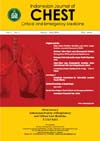 TUBERKULOSIS PADA TRANSPLANTASI ORGAN
Vol 5 No 4 (2018)
TUBERKULOSIS PADA TRANSPLANTASI ORGAN
Vol 5 No 4 (2018)Melsa Aprima1, Fauzar2
1 Program Studi Pendidikan Dokter Spesialis Ilmu Penyakit Dalam, FK UNAND/RS M Djamil, Padang
2 Divisi Pulmonologi dan Kedokteran Respirasi, Departemen Ilmu Penyakit Dalam
FK UNAND/RS M Djamil, PadangABSTRAK
Tuberkulosis (TB) hingga saat ini masih menjadi masalah kesehatan masyarakat. Pasien transplantasi organ
memiliki risiko tinggi untuk terinfeksi Mycobacterium tuberculosis. Frekuensi dan angka mortalitas TB pada
pasien transplantasi organ lebih tinggi dibandingkan populasi umum. Diagnosis dan penatalaksanaan TB
aktif maupun TB laten harus dilakukan pada seluruh pasien transplantasi organ.
Kata kunci: Tuberkulosis, Transplantasi organABSTRACT
Tuberculosis is still a public health problem. Organ transplant patients have a high risk of being infected
with mycobacterium tuberculosis. The frequency and mortality rate of TB in organ transplant patients is
higher than the general population. Screening, diagnosis, and management of active or latent TB should be
performed on all organ transplant patients.
Keywords: Tuberculosis, Organ Transplantation -
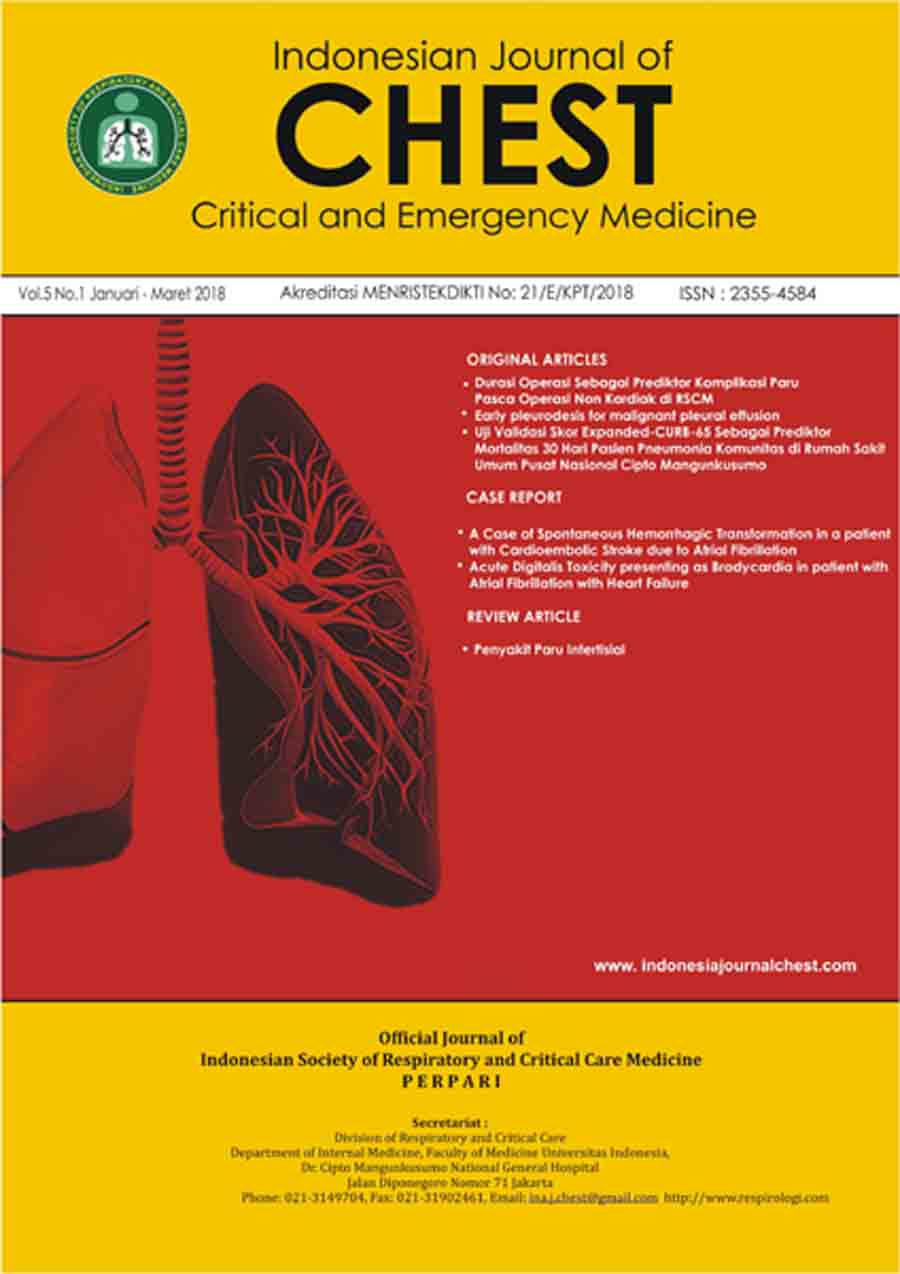 KETIDAKPATUHAN TERHADAP PENGOBATAN PADA PASIEN KOINFEKSI TB HIV
Vol 5 No 3 (2018)
KETIDAKPATUHAN TERHADAP PENGOBATAN PADA PASIEN KOINFEKSI TB HIV
Vol 5 No 3 (2018)
Zulkifli Amin1, Intan Pratiwi2
1 Divisi Respirologi dan perawatan kritis, Departemen Ilmu Penyakit Dalam, Rumah Sakit Umum Nasional Cipto Mangunkusumo Indonesia 2 Asisten Penelitian di Departemen Penyakit Dalam, Rumah Sakit Umum Nasional Cipto Mangunkusumo, IndonesiaABSTRAK
Tuberkulosis (TB) dan HIV/AIDS masih menjadi masalah kesehatan di dunia. Tuberkulosis adalah penyakit yang paling umum di antara orang yang hidup dengan HIV. Pasien koinfeksi TB/HIV adalah masalah yang kompleks. Oleh karena itu, perawatan seringkali dapat menjadi rumit disebabkan kondisi medis dan adanya kesulitan kondisi sosial. Kondisi ini dapat membuat pasien tidak patuh dalam menjalani pengobatan. Tenaga kesehatan masyarakat memiliki peran penting dalam menyelesaikan masalah ini.
Kata kunci: ketidakpatuhan, pengobatan, koinfeksi, TB/HIV -
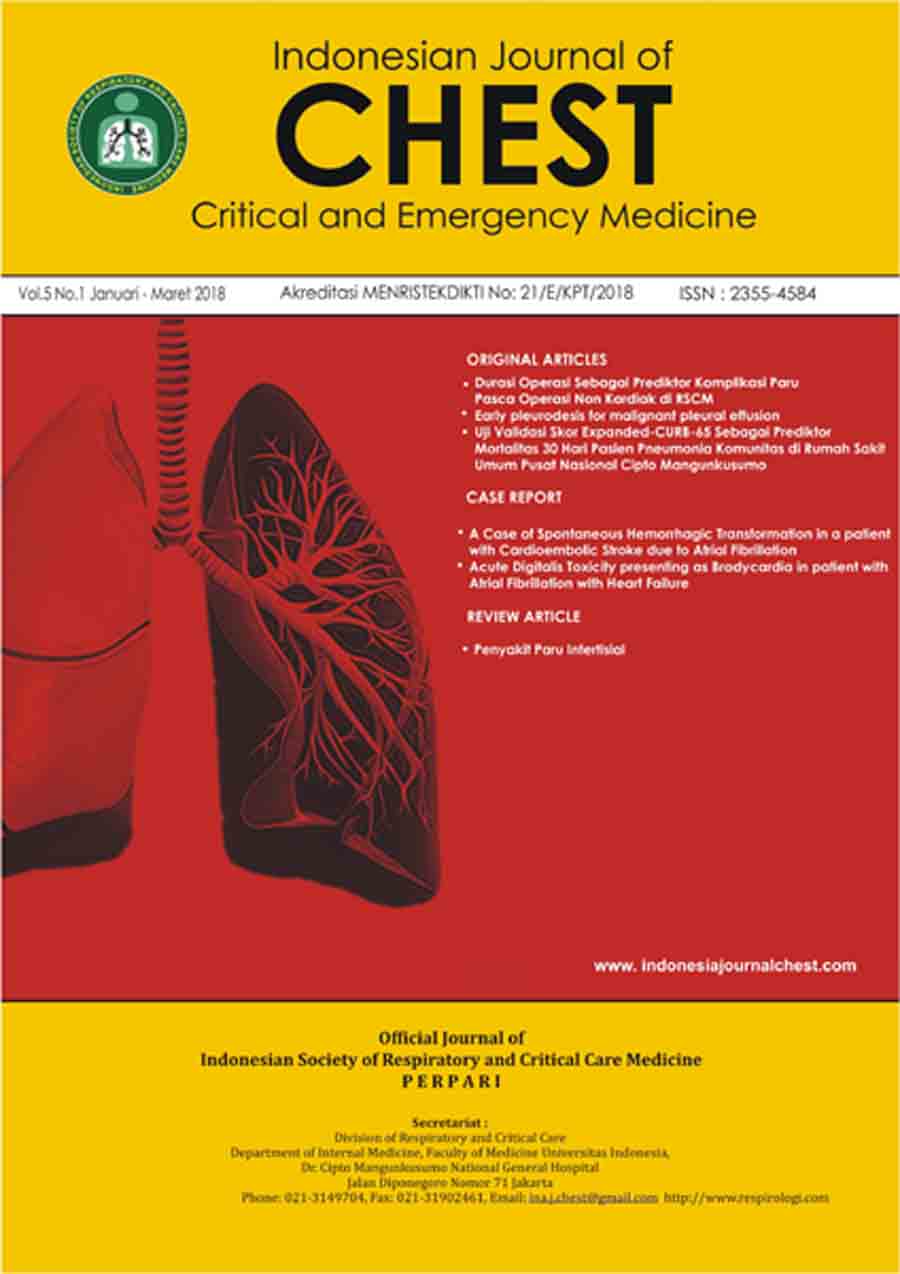 LAPORAN TIGA KASUS TUBERKULOSIS EKSTRA PARU
Vol 5 No 3 (2018)
LAPORAN TIGA KASUS TUBERKULOSIS EKSTRA PARU
Vol 5 No 3 (2018)Dewi Resnawita, Marlina Rays, Harun Iskandar, Eliana Muis, Muhammad Ilyas,
Nur Ahmad Tabri, Irawati Djaharuddin, Erwin Arief, A. Makbul Aman, Syakib Bakri
Departemen Ilmu Penyakit Dalam Fakultas Kedokteran Universitas HasanuddinABSTRAK
Tuberkulosis (TB) merupakan penyakit infeksius yang dapat mengancam nyawa dengan angka
insidensi yang tinggi di dunia, terutama di negara-negara berkembang seperti Indonesia. Meskipun
sebagian besar kasus TB ditemukan pada paru-paru, proporsi pasien yang mengalami infeksi TB
ekstra paru juga menunjukkan angka yang signifikan. Berikut dilaporkan tiga kasus TB ekstra paru.
Kasus pertama, wanita 63 tahun dengan gambaran klinis benjolan pada daerah mulut yang awalnya
diperkirakan menderita tumor kemudian dilakukan pemeriksaan histopatologis diperoleh hasil
peradangan kronik granulomatous. Kasus kedua, wanita 32 tahun dengan gambaran klinis berupa
plak hiperkeratosis, eritema dan skuama regio interphalang digiti dua dextra kemudian dilakukan
pemeriksaan histopatologis diperoleh hasil Tuberkulosis kutis verukosa. Kasus ketiga, laki-laki 32
tahun, dengan nyeri dan bengkak pada lutut kanan kemudian dilakukan pemeriksaan histopatologis
diperoleh hasil radang kronik granulomatosa supuratif. Terhadap ketiga pasien ini diberikan obat
anti tuberkulosis (OAT) kategori I 2(HRZE)/4(HR)3 dan terjadi perbaikan klinis.
Kata kunci: TB ekstra paru, obat anti tuberkulosis -
 SUCCESSFUL MANAGEMENT OF RESPIRATORY FAILURE FOLLOWING SNAKEBITE IN GERIATRIC PATIENT
Vol 5 No 3 (2018)
SUCCESSFUL MANAGEMENT OF RESPIRATORY FAILURE FOLLOWING SNAKEBITE IN GERIATRIC PATIENT
Vol 5 No 3 (2018)Randy Adiwinata1, Josephine Rasidi1,
Muhammad Reza Arifianto2,
Mohammad Darwis Dahlan3,
Sarmauli Sitorus4,
Benny Indrajaya5,
Restu Ratnaningsih6, Erni Juwita Nelwan7
1Faculty of Medicine, Atma Jaya Catholic University of Indonesia, Jakarta, Indonesia
2Faculty of Medicine, Hang Tuah University, Surabaya, East Java, Indonesia
3Department of Surgery, Kanujoso Djatiwibowo Hospital, Balikpapan, East Kalimantan, Indonesia
4Department of Neurology, Kanujoso Djatiwibowo Hospital, Balikpapan, East Kalimantan, Indonesia
5Department of Anesthesiology, Kanujoso Djatiwibowo Hospital, Balikpapan, East Kalimantan, Indonesia
6Department of Internal Medicine, Kanujoso Djatiwibowo Hospital, Balikpapan, East Kalimantan, Indonesia
7Division of Tropical and Infectious Disease, Department of Internal Medicine, Faculty of Medicine Universitas Indonesia, Jakarta, Indonesia.ABSTRACT
Introduction: Neurotoxicity manifestations following venomous snakebite may lead to lifethreatening
conditions such as respiratory muscle paralysis leading to respiratory failure and loss
of consciousness. Prompt treatments are required.
Case illustration: A-90-year-old woman presented with loss of consciousness and respiratory
failure following snakebite. On general examination, a patient was unconscious (Glasgow Coma
Score [GCS] 3) with respiratory rate 4-6 rates per minute and frequent apnea period. Her blood
pressure was 267/155 mmHg with sinus tachycardia (150 bpm) and low oxygen saturation (50-
65%). Early intubation was performed due to respiratory failure. Rapid neurological improvement
was seen after snake antivenom and anticholinesterase administration. She was discharged on the
fifth day without any neurotoxic sign.
Discussion: The respiratory failure and loss of consciousness were regarded as acute and severe
neurotoxic envenoming. Geriatric patient may have reduced respiratory capacity which may further
accelerate the respiratory failure. Neurotoxin acted at the pre- and post-synapse neuromuscular
junction. Antivenom is the only definitive therapy in envenoming. Trial of anticholinesterase should
always be conducted in neurotoxic envenoming. Early mechanical ventilation support should be
given in respiratory failure cases.
Conclusion: Antivenom administration and trial of anticholinesterase should be performed in
neurotoxicity envenoming. Mechanical ventilation should not be delayed in present of respiratory
failure.
Keywords: venomous snakebite, respiratory failure, neurotoxin, snake antivenom -
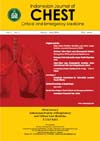 Perbandingan Perbaikan Nilai Peak Ekspiratory Flow Penggunaan Aminofilin Dan Salbutamol Pada Eksaserbasi Asma
Vol 5 No 2 (2018)
Perbandingan Perbaikan Nilai Peak Ekspiratory Flow Penggunaan Aminofilin Dan Salbutamol Pada Eksaserbasi Asma
Vol 5 No 2 (2018)Amelia Lorensia1, Zullies Ikawati2, Tri Murti Andayani2, Daniel Maranatha3
1Department of Clinical pharmacy-Community, Faculty of Pharmacy, University of Surabaya, Jl. Raya Kalirungkut, 60293 Indonesia
2Department of Pharmacology and Clinical Pharmacy, Faculty of Pharmacy Universitas Gadjah Mada, Sekip Utara Yogyakarta, 55281 Indonesia
3Department of Pulmonology and Respiratory Medicine, Faculty of Medicine, University of Airlangga, General Hospital Dr. Soetomo, SurabayaABSTRACT
Background: Intravenous aminophylline is one of the most frequent exacerbations of asthma therapy in Indonesia. Even abroad, the use of aminophylline / theophylline is often used because of higher and better effectiveness than the first line, ie salbutamol nebulasi.
Objective: To determine the effectiveness of salbutamol mebulasi and aminophylline intravenously on exacerbation of asthma in improving lung function with peak expiratory flow (PEF) value with peak flow meter.
Method: This study used quasi experimental method, with research variable is PEF value. The study was conducted from January 2014 to June 2016. The study subjects were adult patients with asthma exacerbations in hospital in Surabaya, with consecutive sampling method. Test the dependent sample t-test (scale scale) to see the population in one group and test the independent sample t-test (scale scale) to see the differences between groups.
Results: This study activated 27 subjects in group A (intravenous aminophylline) and 30 people in group B (salbutamol nebulasi). The comparison of PEF improvements between the two groups used an independent sample t-test, which had previously been tested for normality with Shapiro Wilk with a p value of 0.001 (group A) and 0.001 (group B) which was not published by parametric tests. And after administration of asthma therapy, there is no number equal to both, both intravenous aminophylline and nebulized salbutamol.
Conclusion: The effectiveness of intravenous aminophylline is no different from salbutamol nebula in the improvement of PEF values.
Keywords: exacerbation of asthma, intravenous aminophylline, salbutamol nebulation, peak expiratory flow -
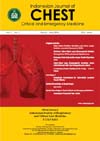 Efikasi dan Manfaat Klinis Terapi Steroid Sistemik dan Inhalasi pada Pasien Community-Acquired Pneumonia
Vol 5 No 2 (2018)
Efikasi dan Manfaat Klinis Terapi Steroid Sistemik dan Inhalasi pada Pasien Community-Acquired Pneumonia
Vol 5 No 2 (2018)Fahreza Akbar Siregar1, Gurmeet Singh2
1Program Studi Pendidikan Dokter, Fakultas Kedokteran Universitas Indonesia, Jakarta
2Divisi Pulmonologi dan Kedokteran Respirasi, Departemen Ilmu Penyakit Dalam, Rumah Sakit Umum Pusat Nasional Cipto Mangunkusumo, JakartaABSTRACT
Background: Community-acquired pneumonia (CAP) is one of the top leading causes of mobidity and mortality worldwide. CAP also becomes the sixth most prevalent cause of overall mortality in adults. Corticosteroids are known to be the most potent anti-inflammatory drugs and have physiologic rationale for their use in patients with infection. Its efficacy in the treatment of CAP is still debatable. Objective: This study aims to evaluate the efficacy and clinical outcomes of systemic and inhaled steroid therapy for patients with community-acquired pneumonia.
Methods: We used four databases for literature searching process, Pubmed, EBSCO, ProQuest, and Science Direct, which selected articles are those therapeutic studies with relevant clinical question and met the inclusion-exclusion criterias. Critical appraisal was performed by assessed its validity, importance, and applicability based on Oxford Center of Evidenced-Based Medicine 2011. Results: Three retrieved articles feature cohort studies. Two studies conducted systemic steroid therapy research which other conducted inhaled steroid. Two of three articles show steroid therapy was associated with lower mortality and shorter clinical stability.
Conclusion: We suggested that steroid therapy, both systemic and inhaled steroids help hasten clinical recovery, prevent pneumonia-related complication, lower mortality, and reduction in the duration of mechanical ventilation and length of hospital stay.Keywords: community-acquired pneumonia, steroid, inhalation, therapeutics, clinical outcomes
-
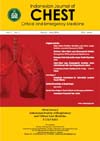 Interstitial Lung Disease in Systemic Sclerosis
Vol 5 No 2 (2018)
Interstitial Lung Disease in Systemic Sclerosis
Vol 5 No 2 (2018)Puji Astuti Tri K1, Anak Agung Arie1, Cleopas Martin Rumende2, Zulkifli Amin2
1)Internal Medicine Department, Cipto Mangunkusumo National General Hospital-Faculty of Medicine, Universitas Indonesia
2)Division of Respirology and Critical Care, Internal Medicine Department, Cipto Mangunkusumo National General Hospital-Faculty of Medicine, Universitas IndonesiaABSTRACT
Systemic sclerosis (SSc) is a chronic tissue disorder characterized by immune dysfunction, microvascular injury, and fibrosis. Many organs involved in patients with SSc; especially, pulmonary involvement occurs in up to 90% of patients with SSc. Interstitial lung disease (ILD) is a major complication in SSc and causing high mortality rate. The SSc-ILD therapy is basically consistent with the progress of scleroderma pathophysiology. We reported a case of 59-years-old female patient with a blackened ulcer on her left hand ring finger with disappearing of her distal finger segment, and also a chronic white phlegm cough followed by dyspnea in exertion. Clinical examination and evaluation showed that she had a scleroderm, accompanied with ILD. Her complaint did not improve, so she got an immunosuppresant and supportive therapy to control her worsening disease.
Keywords: systemic sclerosis, interstitial lung disease -
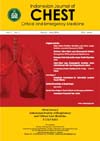 Tranquilizer effect in premature ventricular contractions
Vol 5 No 2 (2018)
Tranquilizer effect in premature ventricular contractions
Vol 5 No 2 (2018)Lidya Lustoyo Putrajaya1, Ari Sisworo2
1General Practitioner at East Belitung District Regional Public Hospital, East Belitung, Indonesia; 2Internist at East Belitung District Regional Public Hospital, East Belitung, IndonesiaAbstract
Premature ventricular contractions (PVCs) are early depolarizations begin in the ventricle instead of the usual place, the sinus node. Frequent and complex PVCs could occur in apparently healthy individuals, they also showed it could be associated with a benign prognosis. PVCs may occur at rest or during exertion, or as a result of excessive caffeine intake, smoking, drinking alcohol, the use of illicit drugs (e.g., cocaine, amphetamines), or the use of over-the-counter medications (e.g., diet pills, antihistamines) that contain ingredients that mimic the effects of sympathetic nervous system stimulation. In individuals with and without heart disease, hypokalemia and hypomagnesaemia often contribute to the development of PVCs. The symptoms that can occur are palpitations, lightheadedness, passing out, chest pain, and shortness of breath. If the patient without heart disease feels any discomfort, he/ she could be given minor tranquilizer such as benzodiazepine.
Keywords: Premature Ventricular Contractions, Sympathetic nervous system, Tranquilizer, Benzodiazepine -
 Premature Ventricular Complex-Induced Cardiomyopathy
Vol 5 No 2 (2018)
Premature Ventricular Complex-Induced Cardiomyopathy
Vol 5 No 2 (2018)Raymond Pranata1, Emir Yonas2, Veresa Chintya3
1Assistant Physician, Siloam General Hospital - Faculty of Medicine, Universitas Pelita Harapan, Tangerang, Banten, Indonesia
2Faculty of Medicine, YARSI University, Jakarta, Indonesia
3General Practitioner, Sanjiwani General Hospital, Gianyar, Bali, IndonesiaABSTRACT
Introduction: Frequent premature ventricular complexes (PVCs) have theability to cause or contribute to cardiomyopathy and heart failure symptoms in long-term.
Case Illustration: A 46 years old male presented with recurrent palpitations, the latest since 6 hours before admission. PMH of hypertension, diabetes and heart disease were denied. BP: 120/80 mmHg, HR: 138 bpm, RR 22x/minute. ECG: LV focus multifocal PVC bigeminy. Lab: within normal limits. CXR: cardiomegaly. Echocardiography: MR and LVH. The patient was administered diltiazem IV in the ED. Bisoprolol was given during discharge.
Discussion: PVC-induced cardiomyopathys mechanisms are not entirely clear; a more likely explanation is abnormal ventricular activation resulting in mechanical dyssynchrony, >10.000 PVCs/day has high risk and this patients PVC burden should be calculated. It is a diagnosis of exclusion andmade after exploring possible causes and excluding them.Pharmacotherapy to suppress PVCs includes ?-Blockers, CCB, and other antiarrhythmic drugs. Results of the use of ?-Blockers and CCB are modest with reported efficacy rates in the 20% range.In patients with PVC-induced cardiomyopathy, successful elimination of PVCs with ablation frequently restores ventricular function acutely and has aprocedural success rate of PVC elimination of 84%. Unfortunately, this patient is not a suitable candidate for catheter ablation. Hence, ?-Blockers was chosen for long-term therapy.
Conclusion: Frequent PVCs with high burden has potential to cause adverse cardiovascular events and should be treated to prevent its deleterious consequences. Suppression of PVCs using either antiarrhythmic pharmacological agents or emerging catheter ablation techniques appears to reverse the LV dysfunction.
Keywords: PVC, Cardiomyopathy, burden -
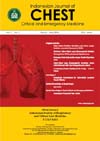 Durasi Operasi Sebagai Prediktor Komplikasi Paru Pasca Operasi Non Kardiak di RSCM
Vol 5 No 1 (2018)ABSTRAK
Durasi Operasi Sebagai Prediktor Komplikasi Paru Pasca Operasi Non Kardiak di RSCM
Vol 5 No 1 (2018)ABSTRAKLatar belakang: Di Indonesia, sebanyak 18,4 % pasien yang menjalani operasi non-kardiak di RSUPN Cipto Mangunkusumo Indonesia mengalami Komplikasi Paru Pasca Operasi(Post-operative Pulmonary Complication/PPC).Beberapa penelitian menunjukkan durasi operasi memiliki hubungan dengan PPC.Penelitian ini bertujuan untuk mengetahui peranan durasi operasi sebagai prediktor kejadian komplikasi gagal napas dan pneumonia dalam 30 hari pasca operasi.
Metode: Penelitian menggunakan desain kohort retrospektifpada November 2016-Juli 2017dengan data rekam medis pasien yang menjalani operasi di RSUPN Cipto Mangunkusumo tahun 2012-2016.Sampel penelitian diambil dengan metode consecutive samplingyang memenuhi kriteria inklusi dan eklusi, dilihat luarannya selama 30 hari pasca operasi.
Hasil: Dari 102 pasien diketahui 58,8 % perempuan, 35,5 % 41-50 tahun, 25,5 %berpendidikan SMA, 34,3 % tidak bekerja, 77,5 % tidak mengalami penurunan berat badan, 80,4 % tidak merokok, tidak ada yang memiliki riwayat PPOK, 61,8 % anestesi umum, 64,7 % operasi elektif dan 51,96 % lokasi operasi di abdomen. Didapatkan 10,8 % mengalami gagal napas dan 6,9 % mengalami pneumonia. Dari analisis bivariat, durasi operasi tidak dapat digunakan sebagai prediktor kejadian gagal napas (p 0,106; RR 3,56; CI 95 % 0,885 -14,280) maupun pneumonia (p 0,701; RR 1,61; CI 95 % 0,342-7,601).
Kesimpulan:Durasi operasi tidak dapat digunakan sebagai prediktor tunggal dalam memprediksi kejadian komplikasi gagal napas maupun pneumonia pasca operasi.
Kata kunci:durasi operasi, gagal napas,komplikasi paru pasca operasi,pneumonia



